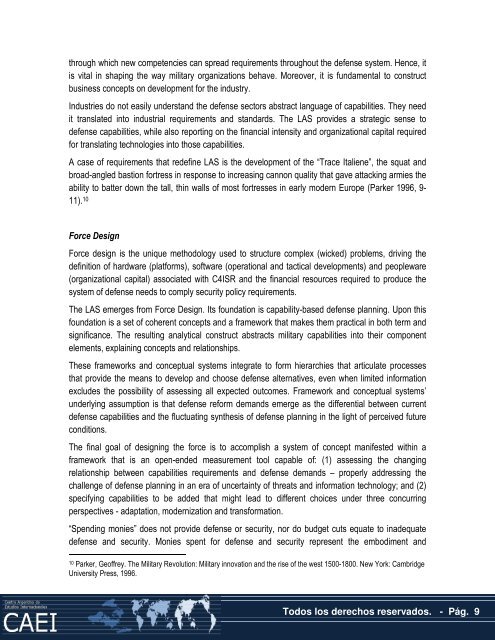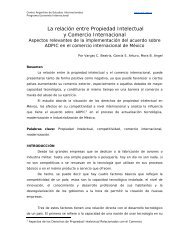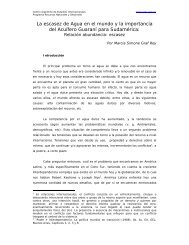Brazil's Defense Industry: The Emerging Transformational ... - CAEI
Brazil's Defense Industry: The Emerging Transformational ... - CAEI
Brazil's Defense Industry: The Emerging Transformational ... - CAEI
Create successful ePaper yourself
Turn your PDF publications into a flip-book with our unique Google optimized e-Paper software.
through which new competencies can spread requirements throughout the defense system. Hence, it<br />
is vital in shaping the way military organizations behave. Moreover, it is fundamental to construct<br />
business concepts on development for the industry.<br />
Industries do not easily understand the defense sectors abstract language of capabilities. <strong>The</strong>y need<br />
it translated into industrial requirements and standards. <strong>The</strong> LAS provides a strategic sense to<br />
defense capabilities, while also reporting on the financial intensity and organizational capital required<br />
for translating technologies into those capabilities.<br />
A case of requirements that redefine LAS is the development of the “Trace Italiene”, the squat and<br />
broad-angled bastion fortress in response to increasing cannon quality that gave attacking armies the<br />
ability to batter down the tall, thin walls of most fortresses in early modern Europe (Parker 1996, 9-<br />
11). 10<br />
Force Design<br />
Force design is the unique methodology used to structure complex (wicked) problems, driving the<br />
definition of hardware (platforms), software (operational and tactical developments) and peopleware<br />
(organizational capital) associated with C4ISR and the financial resources required to produce the<br />
system of defense needs to comply security policy requirements.<br />
<strong>The</strong> LAS emerges from Force Design. Its foundation is capability-based defense planning. Upon this<br />
foundation is a set of coherent concepts and a framework that makes them practical in both term and<br />
significance. <strong>The</strong> resulting analytical construct abstracts military capabilities into their component<br />
elements, explaining concepts and relationships.<br />
<strong>The</strong>se frameworks and conceptual systems integrate to form hierarchies that articulate processes<br />
that provide the means to develop and choose defense alternatives, even when limited information<br />
excludes the possibility of assessing all expected outcomes. Framework and conceptual systems’<br />
underlying assumption is that defense reform demands emerge as the differential between current<br />
defense capabilities and the fluctuating synthesis of defense planning in the light of perceived future<br />
conditions.<br />
<strong>The</strong> final goal of designing the force is to accomplish a system of concept manifested within a<br />
framework that is an open-ended measurement tool capable of: (1) assessing the changing<br />
relationship between capabilities requirements and defense demands – properly addressing the<br />
challenge of defense planning in an era of uncertainty of threats and information technology; and (2)<br />
specifying capabilities to be added that might lead to different choices under three concurring<br />
perspectives - adaptation, modernization and transformation.<br />
“Spending monies” does not provide defense or security, nor do budget cuts equate to inadequate<br />
defense and security. Monies spent for defense and security represent the embodiment and<br />
10 Parker, Geoffrey. <strong>The</strong> Military Revolution: Military innovation and the rise of the west 1500-1800. New York: Cambridge<br />
University Press, 1996.<br />
9<br />
Todos los derechos reservados. - Pág. 9

















